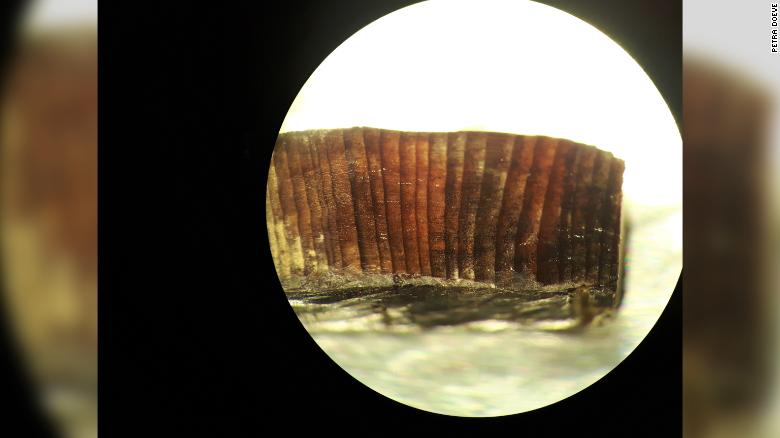These runestones tell of the country's Viking past 1:04
(CNN) -
The Vikings used their ships to cross the Atlantic Ocean and had already settled in Canada by the year 1021, according to a new study that provides the exact first date of the presence of Europeans in America.
The study examined previously undated wooden artifacts from a Viking settlement in Newfoundland, Canada, which provide the first known record of humans crossing the Atlantic to reach the American continent.
Archaeologists discover with radars a Viking ship in Norway
The site, known as L'Anse aux Meadows, is located on the Newfoundland peninsula.
The researchers came up with the final date thanks to two unlikely sources: cut wood and a solar storm that occurred more than a thousand years ago.
When the Vikings arrived at L'Anse aux Meadows, they cut down the trees with metal blades that were not made by the indigenous population living in the area at the time.
The pieces of wood that remained in the settlement came from three different trees.
This reconstructed building from the Viking age stands next to the site of L'Anse aux Meadows.
In the cut trees, the rings could be identified, including a clear marker from the year 993. Scientists know that a huge solar storm occurred the previous year that released a stream of cosmic rays, or highly energetic particles from the Sun at almost the speed of the light.
This left a remarkable and distinctive signature on the tree rings for the year 993.
advertising
"The clear increase in carbon-14 production that occurred between 992 and 993 has been detected in the archives of tree rings around the world," says Michael Dee, lead author of the study and associate professor of Isotopic Timeline at the University of Groningen, The Netherlands.
All three wooden objects show the same signal from the solar storm exactly 29 growth rings before reaching the edge of the crust.
"Finding the signal of the solar storm at 29 growth rings of the crust allowed us to conclude that the cut happened in the year 1021," said Margot Kuitems, co-author of the study and postdoctoral researcher at the University of Groningen.
The study that includes these findings was published Wednesday in the journal
Nature
.
When did humans start wearing clothes?
A discovery in a Moroccan cave could illuminate the question
Global exploration
This date suggests that it is the first known presence of Europeans on the continent before Christopher Columbus, as well as the first proof of all human migrations and explorations that the Atlantic had been crossed, Dee said.
Vikings also settled in Iceland and Greenland to the west, before reaching the site of L'Anse aux Meadows.
"The Vikings are believed to have ventured west to find new raw materials, especially wood," Dee said.
"Traveling between continents in search of these materials has been described as the first step of globalization."
Although the exact number of trips to the Americas and how long they stayed there is unclear, current evidence shows that it was probably a short stay for the Vikings.
But there is evidence at the L'Anse aux Meadows site that the Vikings explored areas south of Newfoundland while in America.
Previous attempts to understand when the Vikings came to America have been based on the Icelandic sagas, but these were oral histories written centuries after they actually occurred.
The sagas are full of fantastic notes, but they also point to possible encounters between the Vikings and the indigenous people of America.
Some of these events are described as friendly and others as violent.
This microscope image shows rings within a wood fragment from L'Anse aux Meadows.
By checking them against medieval texts, including one recently discovered, it appears that other Europeans were aware that the Vikings had arrived in a new land on the other side of the Atlantic.
The combination of modern research techniques and the discovery of other texts could help establish a chronology of the Vikings in the Americas, and who else knew it, Dee said.
A new find shows that animal life may have existed millions of years earlier than previously thought
Following in the footsteps of the Vikings
But finding archaeological evidence to support the stories of the sagas is much more difficult.
"This date serves as an anchor point for the Icelandic sagas," Dee said.
"It conforms somewhat to the date estimates based on these sagas, and thus adds some credibility to the stories they contain about exploring the Americas and interacting with indigenous people. Otherwise, it is later than what. that most saga experts would have expected. "
Previously, researchers believed that Vikings had arrived on the continent in the late 990s or early 1000s.
"This means the Vikings were there a little later in time, or they came and went for a longer period of time, or they stayed at the site longer than most would have expected," Dee said.
Utilizing cosmic ray events could help researchers study and date other historical sites believed to be of Viking or medieval origin, as there are at least two events that occurred during this period, in 775 and 775. 993. Researchers are also trying to track other solar storms and have confirmed another that occurred in 660 BC.
This aerial view shows reconstructed buildings near L'Anse aux Meadows.
Dee's team used this dating method at another historical site of unknown age prior to the more accurate carbon-14 dating.
In the future, Dee and his colleagues want to delve into the history of Nordic exploration of the North Atlantic, he said.
They are already applying their dating method to other "chronological issues" around the world.
"Over time, hopefully these investigations will provide new insights that explain the history of the human past," Dee said.
vikings









